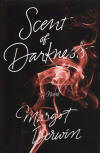Scent of Darkness
This novel’s title and cover image, of reddish curls of smoke, inspires assumptions that another vampire story is lurking in our midst, quietly digging its fangs on an ever-crowded genre dominated by pale, gorgeous characters, 500-year-old blood-suckers whose sense of smell defies any human standard of keenness. In the novel’s first paragraph, the narrator’s revelation of a loss—of “something very special . . . running through [her] veins like a blessing, or a plague”—appears to support that impression, that perhaps she is referring to properties in her blood, of being trapped in the vacuum of eternity itself. Even the narrator’s name—Eva—has strong kinship to blood, old blood, the origin of blood, fallen, cast away from innocence, purity. It’s hard to say where our impression of vampires eventually fades in the story; Margot Berwin’s canvas is filled with shadows, quiet rooms with creaky doors, cloudy skies, and lonely roads, whether Eva is in the mountaintop town of Cyril, New York where her grandmother Louise lives, or in the tropical weather of New Orleans, where Eva shacks up with her boyfriend Gabriel after Louise—an aromata, a master creator of scent—passes away.
This novel’s title and cover image, of reddish curls of smoke, inspires assumptions that another vampire story is lurking in our midst, quietly digging its fangs on an ever-crowded genre dominated by pale, gorgeous characters, 500-year-old blood-suckers whose sense of smell defies any human standard of keenness. In the novel’s first paragraph, the narrator’s revelation of a loss—of “something very special . . . running through [her] veins like a blessing, or a plague”—appears to support that impression, that perhaps she is referring to properties in her blood, of being trapped in the vacuum of eternity itself. Even the narrator’s name—Eva—has strong kinship to blood, old blood, the origin of blood, fallen, cast away from innocence, purity. It’s hard to say where our impression of vampires eventually fades in the story; Margot Berwin’s canvas is filled with shadows, quiet rooms with creaky doors, cloudy skies, and lonely roads, whether Eva is in the mountaintop town of Cyril, New York where her grandmother Louise lives, or in the tropical weather of New Orleans, where Eva shacks up with her boyfriend Gabriel after Louise—an aromata, a master creator of scent—passes away.
A chunk of Berwin’s plot blossoms in that southern city, a city that, to Eva, appears an alternative to reality itself: “like a dream [she] couldn’t control over, with stories coming from everywhere that just kept moving forward and changing . . . no backtracking, no thinking things over, only movement that was slow and dreamy but forward nevertheless.” Eva’s senses are highly receptive to this aspect of New Orleans, because of what is already in her, the scent her grandmother had created back in Cyril. Contained in a ruby vial, Louise has forbidden her granddaughter to open the container through a note saying that, once exposed, the scent can change Eva’s life: “It can rip your heart or bring you peace. But it can never stop being what it is, Evangeline.” The story hinges around this vial. Louise’s message presents a dilemma, which echoes the biblical dilemma of temptation in the Book of Genesis before the fall. And just like her biblical counterpart, Eva moves beyond the boundary of the forbidden, and leaves hesitations and indecisions behind. Eva opens the vial, and inhales a liquid fog. Although she recognizes “the scent of jasmine from the south of India” in it, and the “unmistakable scent of leather warmed by a slow-burning fire,” her summary of the complex mixture from the vial is burdened with mystery and intrigue: “scent of darkness.”
The scent transforms Eva. Other human beings gravitate to her. They can feel something in her, an incomprehensible desire for her body. At a local concert in Cyril with Gabriel, Eva is mobbed with concertgoers, and has to run away. Even Rayanne, the other girl who harbors feelings for Gabriel, wants to lick Eva’s neck. But it is Gabriel’s friend in New Orleans—Michael Bon Chance—who becomes the gravity of Eva’s attentions. She is awed by his knowledge of what might be in her: “It’s like your soul is on the outside of your body, and now I’ve got some of it for myself.” She shares extracts of her blood for his paintings, a new element in his creations that aspires to revive his career as an artist and widen the possibilities for fame. Besides Louise, Bon Chance is the other artist in the novel that bookends Eva’s life, in the context of scents; he, too, understands the nature of scents, their ability to change and influence moods and feelings, or how its seeming nothingness impacts the body’s sensual nature. Indeed, lust is not a passive but an active element in the novel; it underlines the body language and dialogue of its beautiful people.
Berwin weaves a convincing fable about a scent bleeding with dark sensibilities. You can choose to wake up in that dream and put the book aside, to rest from the thread of ever-looming shadows and scents spreading around you; even Cyril’s local priest, Father Madrid, has a scent, the scent of a fig: “a scent of someone who gives it their all but does not succeed.” But you’ll pick up the book again, because the story refuses to be that scent, and wonder who among Hollywood’s beautiful people might play Michael Bon Chance and Evangeline for any future screen adaptation of the novel. Soon, the darkness in the coffee you’re sipping smells darker, as you step into Eva and Michael’s final moments together, in which their bodies greed for something that can never be quenched or consumed.





